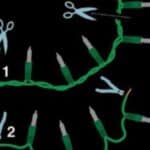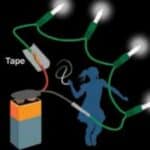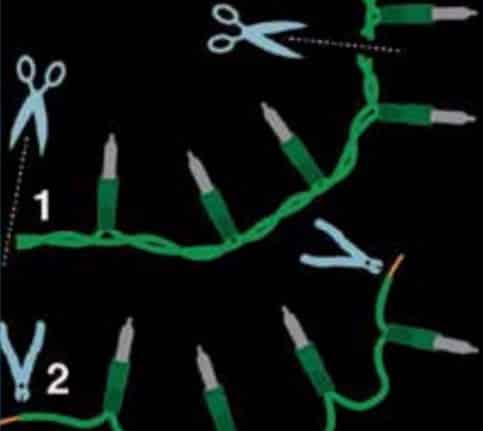Overview
Materials
Per Student or Student Pair:
- 9-volt battery
- Battery snap cap
- A string of ornamental lights that can be destroyed
- Duct tape
- Scissors
- Wire strippers
Instructions
Students learn how to build an electrical circuit out of ornamental lights and a battery.
Safety Note: Light string must be unplugged before cutting.
- Tell students that an electrical circuit needs a source, a line, and a load in order to work. In this case, the battery is the source, the wires in the ornamental lights are the line, and the ornamental lights are the load. The electrical circuit will make the lights glow.
- Instruct students to do the following:
- Cut the two-pronged plug off the lights, as close to the plug as possible.

- Count 4 bulbs from the end of the string and cut them off. Cut the wire as close to the 5th bulb as possible, because you want 3 inches of wire at each end of the string.
- To separate the wires, hold the first bulb and find the plastic-coated wire it is connected to. Untwist this wire from the others so that you end up with 1 wire with 4 bulbs attached.
- Strip off the plastic coating so that you have about 3⁄4″ of exposed metal wire at each end. Important: Don’t press the wire strippers so hard that you cut through the metal wire.

- Pop a snap cap onto the 9-volt battery. Both snap cap wires should have about 1⁄2″ of exposed metal wire at the end. If not, strip them with wire strippers.
- Make a connection by twisting one metal wire from the light string with one of the snap cap’s metal wires. Make the connection solid by using duct tape.
- Complete the circuit by attaching the other two exposed wires as in the previous step.
- Cut the two-pronged plug off the lights, as close to the plug as possible.
- Now instruct students to test the circuit. Do the lights glow? If not, press on the connections inside the tape. Also make sure the battery is fresh enough.
- Explain that students have just made a circuit: all the parts are connected. Electricity flows from the battery to the light and back to the battery, making their lights glow!
Guiding questions
-
Why is it important to strip off the plastic coating?
-
What would happen if you tried to make a circuit with 6 lights? 10?
-
Why do you think ornamental lights don’t work sometimes when you plug them in?
-
What would happen if we took the loads out of the circuit? (Safety caution: do not try this!)
Engineering & science connections
- A circuit is a path along which electricity can travel. Electricity is produced by the flow of subatomic charged particles known as electrons. Electrons are among the smallest known particles and have a size of approximately one quadrillionth of a meter! (A quadrillion is a one followed by 15 zeros.)
- The circuit is the basic building block for all electrical design. Every electrical circuit needs a source, a line, and a load in order to operate. Your entire house is wired using only slightly more complex circuits than you designed in this experiment.
- Using circuits, engineers design distribution systems to provide electricity for the needs of cities, neighborhoods, and buildings. Using more complex types of circuits, engineers design computer chips that operate your phone, tablets, and other computers. These chips send electricity through tiny metal pathways on a plastic board rather than using wires.
This activity was provided by Design Squad Global.
DESIGN SQUAD NATION is produced by WGBH Boston. Major funding is provided by the National Science Foundation. Project funding is provided by Northrop Grumman Foundation and S. D. Bechtel, Jr. Foundation, Additional funding is provided by United Engineering Foundation (ASCE, ASME, AlChE, IEEE, AIME). This DESIGN SQUAD NATION material is based upon work supported by the National Science Foundation under Grant No. EEC-1129342. Any opinions, findings, and conclusions or recommendations expressed in this material are those of the author(s) and do not necessarily reflect the views of the National Science Foundation, ©2012 WGBH Educational Foundation. DESIGN SQUAD and DESIGN SQUAD NATION are trademarks or registered trademarks of WGBH Educational Foundation. All rights reserved. All third party trademarks are the property of their respective owners. Used with permission.


0 Comments